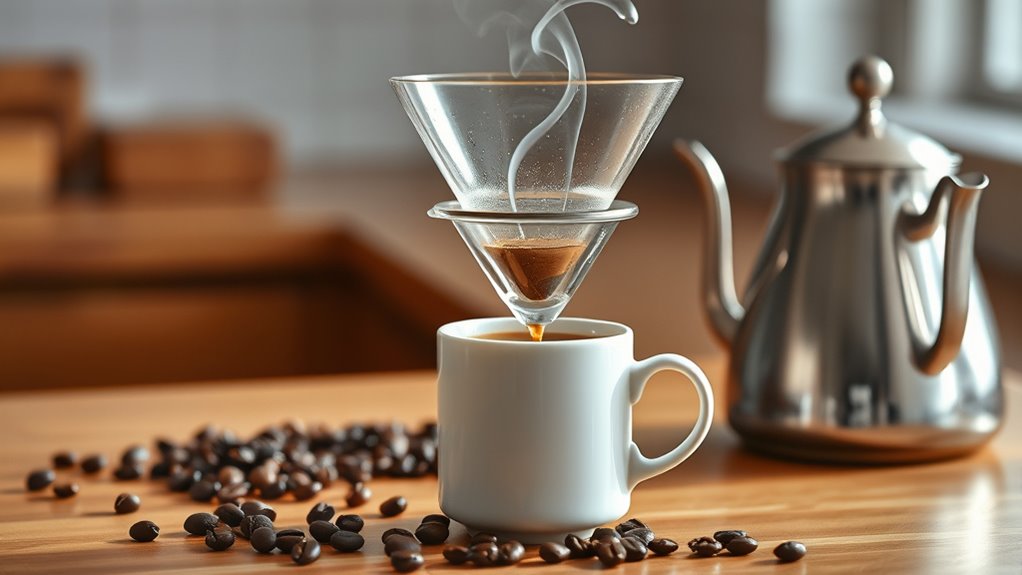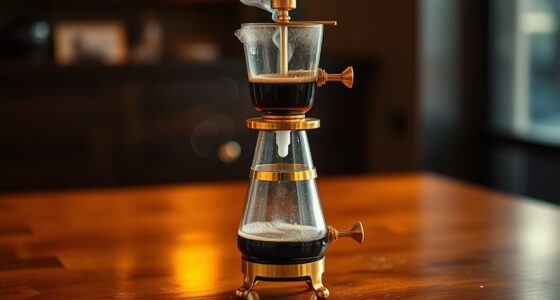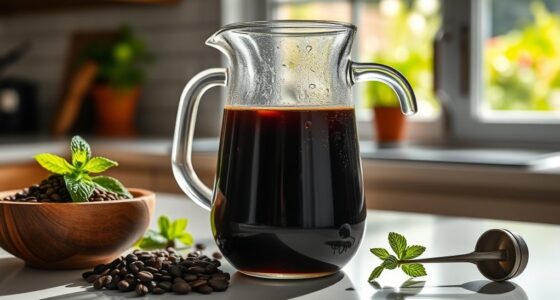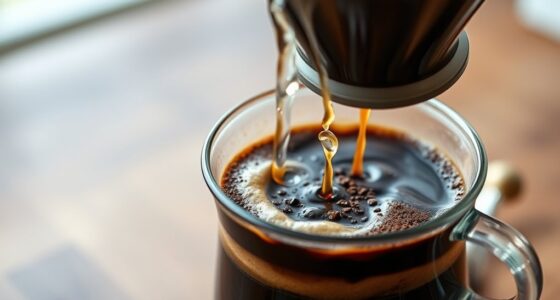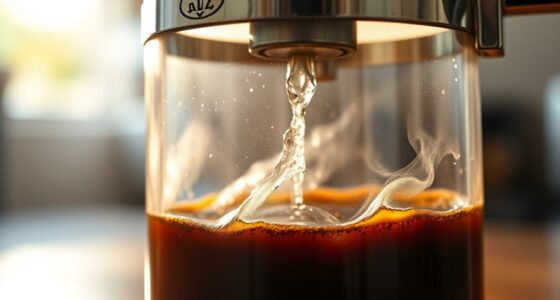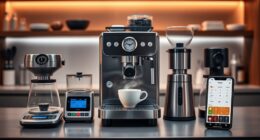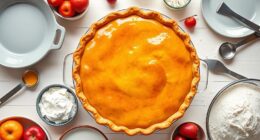To brew the perfect pour-over coffee, start with essential gear like a burr grinder, gooseneck kettle, and digital scale. Use a coffee-to-water ratio of 1:16, measuring precisely for flavor. Begin with a 30-45 second bloom using double the coffee weight in water. Pour slowly in spirals, ensuring even saturation. Monitor your total brew time, aiming for 2:45 to 3:30 minutes. Adjust variables like grind size and water quality to enhance your brew. Discover more tips for perfection!
Key Takeaways
- Use a burr grinder for a consistent grind size, ensuring optimal flavor extraction in your pour-over coffee.
- Maintain a coffee-to-water ratio of 1:16 for balanced flavor, adjusting as necessary for stronger brews.
- Start with a bloom pour using three times the coffee weight in water, allowing 30-45 seconds for gases to escape.
- Pour slowly and steadily using a gooseneck kettle, focusing on even saturation and consistent extraction.
- Rinse your paper filter before brewing to eliminate unwanted tastes and preheat your dripper for better results.
Essential Gear for Pour-Over Coffee

To brew the perfect pour-over coffee, you’ll need some essential gear that makes a real difference.
Start with a burr grinder to achieve a consistent grind size, which is vital for flavor extraction. Next, invest in a gooseneck kettle for precise pouring control; this helps guarantee even saturation of your coffee grounds during the brewing process.
A high-quality paper filter or a stainless steel reusable filter is necessary to prevent any unwanted paper taste and enhance clarity. Don’t forget a reliable dripper like the Chemex or Hario V60, which can greatly improve your brewing experience.
Finally, a kitchen scale is essential for measuring ingredients accurately, helping you maintain the ideal coffee-to-water ratio for peak flavor. Additionally, color accuracy in your brewing equipment can enhance the clarity and richness of your coffee’s flavor profile.
Coffee Measurements and Ratios

Getting the coffee-to-water ratio right is vital to brewing a delicious pour-over. The standard ratio is about 1:16, meaning for every gram of coffee, you should use 16 grams of water.
Getting the coffee-to-water ratio right is essential for a flavorful pour-over, with a standard guideline of 1:16.
Here are some essential measurements to reflect on:
- For a 500ml pot, use 32 grams of coffee with 500 grams of water.
- For a stronger brew, try 30 grams of coffee with 600 grams of water.
- Blooming requires double the water; for 20 grams of coffee, use 60 grams of water.
- Consistent coffee measurements are important; always weigh your coffee and water for best flavor extraction.
Additionally, understanding caffeine content in different brewing methods can help you tailor your pour-over for both flavor and intensity. Experiment with these ratios, adjusting based on personal preferences and brewing temperature, to create your perfect pour-over coffee.
The Brewing Process

Now that you’ve got your coffee measurements down, it’s time to focus on the brewing process.
You’ll need the right equipment and be aware of key variables that can affect your brew.
Let’s go through a step-by-step guide to guarantee you get the best flavor from your pour-over.
Essential Brewing Equipment
While brewing pour-over coffee might seem simple, having the right equipment is necessary for achieving the perfect cup. The following tools will enhance your brewing experience and guarantee a balanced flavor:
- Gooseneck kettle – For precise pouring control, which is essential for even extraction.
- Burr grinder – This guarantees a consistent coffee grind size for ideal flavor release.
- Digital scale – Accurate measurements of coffee and water are crucial for a balanced brew.
- Timer – Tracking brew time helps you perfect your extraction process.
Rinsing your paper filter with hot water is the first step, followed by using a coffee-to-water ratio of 1:16.
With the right equipment, you’ll elevate your pour-over coffee game!
Brewing Variables to Consider
Understanding the brewing variables is essential for perfecting your pour-over coffee. Each factor plays a significant role in achieving that perfect cup. Here’s a quick reference table to guide you:
| Variable | Recommendation |
|---|---|
| Coffee to Water Ratio | 1:16 (20g coffee to 320g water) |
| Blooming Time | 30-45 seconds |
| Total Brew Time | 2:45 – 3:30 minutes |
| Grind Size | Medium to medium-fine |
Pay attention to water quality, as it can greatly affect flavor. Keep your grind size consistent for even extraction. Finally, a gentle swirl during brewing can enhance the distribution of flavors in your coffee grounds. Adjust these variables to tailor your brew to your taste!
Step-by-Step Brewing Guide
With the brewing variables set, you’re ready to create a delicious cup of pour-over coffee. Follow these steps to achieve a perfect final brew:
- Measure 20g of coffee and grind it to a medium-fine consistency. Rinse the paper filter to wet the grounds and preheat your brewer.
- At 0:00, bloom the coffee by pouring 60g of hot water (around 205°F) over the grounds. Let it sit for 30-45 seconds.
- At 0:45, pour an additional 130g of water, ensuring even saturation while gently swirling.
- At 1:45, add the final 130g of water in a spiral motion, aiming for a total brew time of 2:45 to 3:30 minutes.
Monitor the process and make adjustments based on taste preferences!
Blooming Techniques

To achieve the best flavor from your pour-over coffee, mastering the blooming technique is essential.
Start by pouring about three times the weight of your ground coffee in water. For a 20g dose, use around 60g of water. This initial pour allows trapped gases to escape, promoting even extraction and enhancing flavor.
Pour three times the weight of coffee in water for blooming; for 20g of coffee, use 60g of water.
Let it sit for 30-45 seconds, ensuring you saturate all the coffee grounds evenly. Use a gentle, swirling motion starting from the center, which helps prevent bitterness in your final cup.
Keep an eye on the blooming time; under-blooming can lead to sourness, while over-blooming may negatively impact extraction. Proper blooming sets the stage for a cleaner, more nuanced flavor profile in your coffee brewing.
Pouring Techniques

Mastering pouring techniques is essential for achieving the perfect pour-over coffee. Here’s how to get it right:
- Start with a bloom pour, using twice the amount of water to coffee to fully saturate the grounds. Let it sit for 30-45 seconds.
- Use a gooseneck kettle for precise control over flow rate and direction during your pours.
- When pouring the remaining water, do so in slow, steady spirals from the center outward to avoid light spots.
- Aim for about 130g of water per pour, maintaining a 1:16 water-to-coffee ratio for ideal extraction.
Keep an eye on your total brew time, targeting 2:45 to 3:30 minutes for the best flavor balance in your cup.
Adjusting Variables for Flavor

Perfecting your pouring techniques sets the foundation for exceptional pour-over coffee, but adjusting key variables can elevate your brew even further.
Start with the coffee-to-water ratio; using 30g of coffee to 500g of water is a good baseline, but experimenting with ratios like 1:15 or 1:17 can reveal new flavors.
The grind size matters too—a coarser grind reduces bitterness, while a finer grind can fix sourness from under-extraction.
Maintain a brew temperature between 205°F and 210°F for ideal flavor, adjusting for lighter roasts.
Monitor total brew time, aiming for 2:45 to 3:30 minutes, and gently agitate during pouring to promote even extraction, ensuring your fresh coffee shines through in every cup.
Environmental Considerations

When brewing pour-over coffee, consider how your choices impact the environment.
Composting your used coffee grounds not only cuts down on waste but also enriches your garden soil.
You can also explore reusable filter options to reduce single-use waste while still enjoying a great cup of coffee.
Composting Coffee Grounds
Composting coffee grounds is a fantastic way to boost your garden’s health while also doing your part for the environment. Here’s why you should consider using those used coffee grounds:
- Rich in Nitrogen: They provide essential nitrogen, helping your compost pile thrive.
- Soil Structure: Used coffee grounds improve soil drainage and aeration, promoting better plant growth.
- Encouraging Microorganisms: They attract beneficial microorganisms and earthworms, enhancing soil health.
- Sustainability: Composting coffee grounds reduces landfill waste, supporting eco-friendly gardening practices.
Reusable Filter Options
Choosing the right filter for your pour-over coffee can greatly impact both your brew and the environment. Reusable filters, especially stainless steel options, reduce waste by eliminating paper filters, making your brewing practice more environmentally friendly. They slightly alter the flavor profile by allowing more oils and fine particles, enhancing the richness of your brewed coffee. Plus, they’re often more cost-effective in the long run. However, keep in mind that they require regular cleaning to prevent oil buildup. If metal filters aren’t for you, consider biodegradable paper filters or continue composting coffee grounds for an eco-friendly choice. Additionally, opting for reusable filters can contribute to reducing long-term economic costs associated with waste management and environmental degradation.
| Filter Type | Environmental Impact | Flavor Profile |
|---|---|---|
| Reusable Metal | Low waste | Richer, more body |
| Biodegradable Paper | Compostable | Mild, cleaner taste |
| Disposable Paper | High waste | Mild, less body |
Frequently Asked Questions
How to Brew Perfect Pour Over Coffee?
To brew perfect pour-over coffee, start with a 1:16 coffee-to-water ratio. Measure 20g of coffee and 320g of water.
Bloom the grounds by pouring 60g of water first, letting it sit for 30-45 seconds. Then, pour the remaining water in two stages of 130g each.
Keep the water temperature between 205°F and 210°F, and aim for a total brew time of 2:45 to 3:30 minutes for ideal flavor extraction.
What Is the Brew Ratio for Pour Over Coffee?
Imagine waking up to the rich aroma of freshly brewed coffee, just right for your taste.
For pour-over coffee, aim for a brew ratio of about 1:16. That means for every gram of coffee, you’ll need 16 grams of water. If you’re using 20 grams of coffee, pour in 320 grams of water.
Feel free to tweak this ratio, experimenting with flavors that suit your palate best. Consistency is key!
What Is the 4 6 Method Pourover?
The 4 6 Method pourover is a precise brewing technique that focuses on a 1:16 coffee-to-water ratio.
You start with 30 grams of coffee and 480 grams of water.
Begin with a bloom phase, pouring 60 grams of water over the grounds for 30-45 seconds, then add the remaining water in two 180-gram increments.
Aim for a grind size similar to table salt, and keep your water temperature between 205°F to 210°F for ideal flavor.
What Is the Golden Ratio for Coffee Pour Over?
When you think of a perfect cup, imagine a delicate balance between strength and subtlety.
The golden ratio for pour-over coffee is 1:16, meaning for every gram of coffee, you’ll use 16 grams of water.
So, if you’re using 20 grams of coffee, pour in 320 grams of water.
Conclusion
Now that you’ve mastered the art of pour-over coffee, you’re ready to transform your morning routine from mundane to magical. With the right gear and techniques, each cup can bring out rich flavors and aromas, turning a simple brew into an experience. As you adjust variables like grind size and water temperature, you’re not just making coffee—you’re crafting a moment of joy. So, embrace the ritual, and savor the contrast between the ordinary and the extraordinary in every sip.
